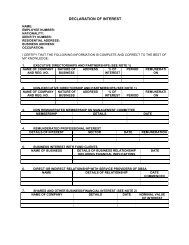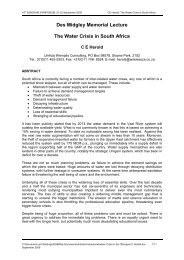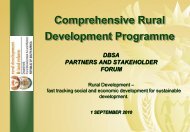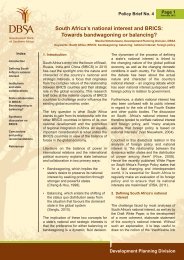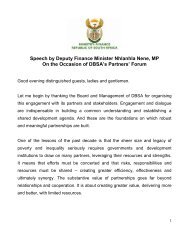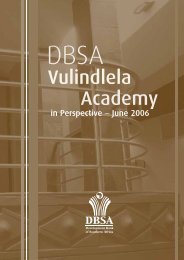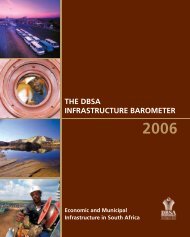ANNUAL REPORTS
ANNUAL REPORTS
ANNUAL REPORTS
You also want an ePaper? Increase the reach of your titles
YUMPU automatically turns print PDFs into web optimized ePapers that Google loves.
Operations overview - South Africa Operations continued<br />
afford services, while the DBSA’s funding costs continued<br />
to increase and unemployment levels escalated after the<br />
international financial crisis. Other issues that emerged<br />
throughout the year were concerns over water quality and<br />
the poor state of education and health services. The Division<br />
responded by exploring various innovative approaches to<br />
leveraging Municipal Infrastructure Grants (MIGs), thereby<br />
fast-tracking the delivery of MIG-linked infrastructure.<br />
A critical issue that emerged in this period is the inadequate<br />
maintenance of established infrastructure. As shown in the<br />
diagram on the previous page, maintenance requirements<br />
are growing, and a significant part of the current discourse<br />
on service delivery is concerned with the deterioration of the<br />
established asset base.<br />
Another concern was poor governance in some municipalities,<br />
as reflected in qualified audits, and a lack of decisive<br />
action by many in the run-up to the 2011 municipal elections.<br />
This negatively affected a number of investment initiatives.<br />
The ability to mobilise resources at a municipal level varies,<br />
with larger, better-endowed municipalities finding it easier to<br />
attract both skills and funding. Commercial banks entered<br />
2010 with excessive liquidity, following conservative lending<br />
practices during the global financial crisis. This resulted in<br />
significant competition to fund the top 40 municipalities,<br />
which have good credit ratings. The remainder, especially<br />
under-resourced and rural municipalities, struggled to raise<br />
capital because of their less attractive risk profiles.<br />
Divisional approach to development support<br />
It is evident from the above that the operating environment<br />
posed various challenges to the Division as it worked to<br />
support infrastructure service delivery. After the record<br />
results achieved in 2009/10, the market contracted. While<br />
needs increased, price-based competition at the higher<br />
end of the municipal market left many poorer municipalities<br />
unsupported. Recognising the institutional constraints faced<br />
by these municipalities, the pressures on service delivery<br />
and the problems of uncoordinated development initiatives,<br />
the Division found innovative ways of extending support.<br />
Whereas the Division used to focus on additionality, only<br />
intervening in cases of market or institutional failure and<br />
adopting a demand-led stance, a new, more proactive<br />
approach is now required to accelerate the delivery of<br />
sustainable solutions at scale.<br />
The Division’s approach during 2010/11 evolved around four<br />
main pillars:<br />
• Innovative, high-impact development interventions to<br />
an expanded client base of intermediaries<br />
In the context of market failure and institutional weaknesses,<br />
a focused, high-impact approach with innovative support<br />
packages across the full value chain was required.<br />
The Division continued to work in close coordination<br />
with the DBSA Development Fund and the Development<br />
Planning Division to provide clients with integrated and<br />
comprehensive development solutions. The Division also<br />
drew in other role players from the public and private sectors<br />
to enhance project development and implementation.<br />
• Strengthened portfolio management<br />
To counteract the effects of financial failure and institutional<br />
weaknesses in intermediaries, the Division intensified<br />
the management of its asset and client base. All clients<br />
with potential problems were identified and monitored,<br />
and specific turnaround interventions were implemented.<br />
This required close cooperation with national government<br />
departments, the Development Fund, the Group<br />
Risk Assurance Division and the Bank’s Workout and<br />
Recovery Unit.<br />
These interventions yielded positive results, as the value of<br />
defaulting clients decreased to 3,8% of the book against<br />
a target of 4,5%. Write-offs were limited to R45 million<br />
(0,2% of the book). In total, provisions for impairments of<br />
R120 million were made, in line with the Bank’s provisioning<br />
principles. The Division also improved its internal<br />
processes to enable the conversion of commitments of<br />
R3,7 billion to disbursements of R3,1 billion. This reflects<br />
a conversion ratio of 75%, which exceeded the historical<br />
norm of 60% by 15 percentage points.<br />
• Prudent financial management<br />
Given the rising cost pressures and lower income levels,<br />
the Division focused on optimising operational expenditure<br />
and achieved a budget saving of 12%. The cost-to-income<br />
ratio was within 5% of the budget, despite disbursement<br />
levels being 15% lower. To counteract the impact of the<br />
price sensitivity in the market, new deals were managed at<br />
margins that could result in conversions and disbursements.<br />
The establishment of the Pricing Committee within the<br />
DBSA created more flexibility in terms of the Bank’s ability<br />
to manage pricing issues in a specific deal.<br />
• Focus on priority sectors with interventions across<br />
the full value chain<br />
The traditional business approaches of client engagement,<br />
bilateral arrangements and open tender for business<br />
remained central to divisional activities. However, given<br />
the price sensitivity in the market and the increasingly<br />
apparent weaknesses revealed by clients in identifying,<br />
packaging and implementing development interventions,<br />
the Division, in collaboration with the DBSA Development<br />
Fund and the Development Planning Division, explored<br />
additional ways to evolve the value offering. This is<br />
illustrated in the diagram on the opposite page.<br />
42<br />
DBSA | <strong>ANNUAL</strong> REPORT 2010/11



